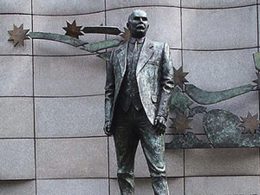In the Early Modern age, millions of acres of common land in Britain were seized by the aristocracy by force in what became known as “the enclosures”, writes Ciaran Mulholland.
For hundreds of generations the poor had grazed this land in common-it belonged to everyone. Between the 17th and the 19th centuries it became private property. The enclosures were a key event in the early development of capitalism in the first industrialised country, Britain.
A second enclosure movement is now in full swing. In the last two decades huge swathes of the world’s public services have been handed over to the private sector. Privatisation, which was first implemented on a significant scale by the Thatcher government in Britain, is one of the key planks of globalisation.
Privatisation has been implemented widely in all the advanced capitalist countries. In the former Soviet Union it was imposed at breakneck speed.
Structural adjustment
Western “shock therapists” guided the rapid transfer of assets from the state to the private sector. There was no shortage of shock but not much in the way of therapy as former Communist Party bureaucrats grabbed the bulk of the available assets. The economy suffered its worst decline since the Nazi invasion of 1942. GDP declined by 42%, mortality rates increased dramatically and the mass of the population were impoverished.
International capitalism, through its institutions (the World Bank, the International Monetary Fund (IMF) and the World Trade Organisation (WTO)), imposes privatisation on the ex-colonial world through “structural adjustment”. Aid is tied to the requirement for poor countries to open up their markets to giant multinational corporations. When the mayor of Cartagena, Colombia for example, tried to reverse the privatisation of the city’s water supply he was told by World Bank officials that privatisation was a condition for the release of aid funds.
And of course privatisation is being implemented by the British and American occupation forces in Iraq-the main beneficiaries are George Bush’s mates in big business.
The scale of worldwide privatisation is immense. Between 1990 and 1999, $900 billion worth of assets were sold (or given away) to the private sector in more than 100 countries. The value of sales grew rapidly through the decade, from $30 billion in 1990 to $145 billion in 1999.
The great giveaway continues to gather speed, unhindered by, or in many cases facilitated by, the ex-parties of the working class, including Blair’s New Labour and the Irish Labour Party, who have embraced the values and the logic of the market. Privatisation has generally been opposed by the trade union movement, but in the vast majority of cases the tops of the unions have made ineffectual protests only, rather than mobilising their members in a real struggle.
North and South further privatisation is on the way. In Northern Ireland the British government, as revealed in recently leaked documents, clearly intends to privatise the water and sewerage service if it can get away with it and more and more private finance is being introduced into education and health. Bertie Ahern is preparing Aer Lingus for sale by making 1,300 workers redundant despite the fact that the company makes a healthy profit. Bus Eireann, Dublin Bus and An Post are also under threat.
Privatisation and globalisation
Privatisation is a key strategy of the ruling classes, nationally and internationally. A whole raft of trade agreements has been put in place to facilitate this strategy. The General Agreement on Trade in Services (GATS) is not designed to improve all our lives but is a set of rules designed to facilitate the corporate takeover of almost every corner of life, including basic needs such as water, education, healthcare, and even the genetic codes for life itself.
Sometimes privatisation is open, simply involving the selling off of assets to the highest bidder. Sometimes, especially when sensitive areas such as health and education are involved, it is covert. The government introduces private money into the public sector and tries to pretend that this is a good thing, as if the private sector is doing us a favour, rather than chasing a quick profit.
The Private Finance Initiative (PFI) and Public Private Partnerships (PPPs, as used in the London Underground) are methods of introducing private finance into the public sector and are central to New Labour’s privatisation strategy in Britain and Northern Ireland.
Under the PFI hospitals are built by the private sector and then leased back to the NHS over 20, 25 or 30 years. Paying the debt is deferred – it is paid from annual income each year. We all know that this is more expensive in the long run – who buys on credit if they are in a position to buy outright?
Furthermore, PFI schemes always result in fewer beds (in Dudley, England for example, 70 fewer), and in job cuts (1,790 in Dudley, where the staff fought long and hard to resist).
The PFI is very attractive to the private sector with its very high rates of return. Total costs (construction costs plus financing costs) in a sample of hospitals built under the PFI are 18-60% higher than construction costs alone. Shareholders in PFI schemes can expect real returns of 15-25% a year. The consortiums involved in these schemes charge the NHS fees equivalent to 11.2-18.5% of construction costs. If the Treasury were to finance new hospitals directly out of its own borrowing, it would pay a real rate of annual interest of 3.0 – 3.5%.
The PFI/PPP approach is being exported. The European Union is at the forefront of these developments and has declared two key goals: reducing public expenditure and creating fresh “opportunities” for private industry in a recent document (“Making the most of opening of public procurement”, 1997).
The global financial institutions that have become the target of anti-globalisation protesters in recent years are also busy promoting public – private partnerships across the globe. There are various types of these partnerships, including what are known as design, build, finance and operate (DBFO); build, own, operate and transfer (BOOT), and build, operate and transfer (BOT) schemes.
When the IMF and the World Bank enforce their economic dictates on developing countries, they insist that all new public infrastructure developments involve PPPs. As a consequence of the imposition of PPPs, massive cuts take place in the existing public sectors, which means that the education sector and health services are worse now than they were in the 1960s in many developing countries.
In 1996 the WTO implemented the “government procurement agreement” which opened up public contracts to international competition and the WTO, IMF and the World Bank all seek to promote “markets in infrastructure provision”. The European Commission has used grants to stimulate the development of PPP’s. The PPP market in 1994 was worth €720 billion, or 11.5% of the gross national product of 15 member states of the European Union, and has grown since.
The European Investment Bank admits that the PPP approach is more expensive than traditional methods of financing, but justifies its adoption by the claims that the private sector is less “risk averse” and hence more efficient. The evidence is that the private sector is very averse to risk indeed. They want to have their cake and eat it. When schemes to provide new computing systems for the national insurance agency and passport agency went belly-up in Britain, the government carried the can, refusing to fire the companies involved even though they were entitled to. The private companies rake in the profit but jump ship when it suits them. The public don’t know everything that goes on as agreements are protected by so-called “commercial confidentiality”.
All governments that accept the restraints of the capitalist system are cutting social spending. Selling off the assets of the state brings a temporary boost to state finances and PPP’s and the PFI give the appearance of keeping down government borrowing in the short term whilst costing much, much more in the long term.
In a further twist in the PFI tale, the private sector consortia involved are lining their pockets even further through “re-financing” deals. Re-financing allows developers to renegotiate the loans they have taken out to build a hospital at a later date (usually when the project is completed and supposed “risks” are past – risks are often overstated in any case). Cheaper loans mean higher returns for shareholders.
The developers who built the £230 million Norfolk and Norwich Hospital in England, for example, are coining an extra £70 million through refinancing. The developers of the new Dartford and Gravesham Hospital in Kent (Carillian, United Medical Enterprises and Innisfree, a specialist PFI investment fund) are seeking to make £30 million through refinancing their £133 million project. The chief executive of Innisfree David Metter, argues that “refinancing is a way of taking profits along the course of a project. It is a reward for the risks that are taken”.
Is privatisation more efficient?
We are told that privatisation will lead to more efficient industries and public services and will thus save money. In fact this is seldom the case. The need to generate a profit pushes up costs and governments can invest more cheaply as they can borrow more cheaply. Of course we are expected to believe that privatisation is good for the economy as a whole, and thus for all of us. The truth is that it benefits the rich. It is estimated that the private sector in Britain will earn £30 billion a year through the PFI.
There are literally thousands of examples of the inefficiencies and the idiocies of the market. In the Dominican Republic electricity prices increased by 51% after privatisation. Blackouts are common. The government however is tied into expensive contracts and by 2000 owed the power companies $135 million.
The privatisation of British Rail has been an unparalleled disaster. The number of train cancellations trebled between 1996 and 1999. Maintaining the rail system has been contracted out to more than 20,000 companies. The result: the disaster at Potters Bar.
When the Conservative government in Ontario, Canada, cut the numbers of water-quality inspection staff and closed government laboratories in favour of private laboratories there was a sharp fall in water quality. As a consequence in the small town of Walkerton, seven people died as result of water contamination.
In South Africa 25% of the country’s 44 million population had their water and electricity disconnected after privatisation. The water service in Lee County, Florida, was returned to public ownership in 2000 after an audit discovered that it was not being maintained adequately by the private sector. It cost $8 million to rebuild the system.
Power companies are enticed into deals by guarantees that the state will purchase electricity at a fixed price for up to 30 years. The privatisation of electricity has been fiercely resisted in India where the Maharashtra State Electricity Board (MSEB) has been obliged to hand over hundreds of millions to the crooked Enron Corporation.
MSEB has been forced to cut production from its own plants in order to fulfill its obligations to Enron. Hundreds of small businesses have closed because they could not afford Enron’s expensive power. As writer and activist Arundhati Roy states “Privatisation is presented as being the only alternative to an inefficient, corrupt state. In fact, it’s not a choice at all…..it’s a mutually profitable business contract between the private company (preferably foreign) and the ruling elite of the third world.”
The main way in which privatisations cut costs is through job losses. In Mexico, for example, the number of members of the railworkers’ union fell from 90,000 to 36,000 when the railways were sold off in the 1990s. In Chile, where privatisation was pioneered by the Chicago monetarists after Pinochet’s bloody coup, employment in the public health sector fell from 110,000 to 53,000 between 1973 and 1988.
PFI plans for a new hospital in Edinburgh project 18% fewer clinical staff and in North Durham 14% fewer nursing staff. According to one of the parasitic consultancy companies that now hovers around the NHS, “each million pounds of incremental PFI capital cost anything from £100,000 to £179,000 a year, requiring the elimination of four to five jobs to pay for it.
An incremental investment of £200 million requires 1,000 job losses, which might be significantly greater than 25% of the work force and is probably only achievable by reducing the number of doctors and nurses, although often these job losses will not be realised within the hospital undertaking the development, but in the local healthcare market” (Newchurch and Company, 1998).
The first PFI hospital
The first PFI hospital to be completed in Britain was opened by Tony Blair to great fanfare in June 1999. It has been a complete disaster. According to The Observer (8 July 2001), “PFI has meant cardiac patients drenched with water flooding from broken pipes, sewage spilling out into the operating theatre, nurses left ventilating patients by hand as operations are plunged into darkness, broken equipment, second-rate maintenance as engineers are made redundant, flea-infested laundry, dirty wards because of cutbacks in cleaners, patients put in chairs because of the reduced number of beds, and dying patients remaining undiagnosed as waiting times doubled”.
The hospital has no air-conditioning and during hot weather temperatures soar to 100 F. Hot weather expands the water pipes, which are joined together by cheap plastic sleeves rather than being soldered, leading to leaks. Cheap plastic joints have also led to ceiling collapses. The emergency generator has failed on a number of occasions plunging the hospital into darkness and causing life support equipment to fail. Equipment breaks down because it is cheap and then cannot be easily fixed because the engineer has been made redundant. As a result operations have been cancelled.
The chairman of the hospital medical staff committee has issued a stark warning: “The developers always think of the bottom line. You have to hold a gun to their head to get them to repair anything. If this is what Blair has in mind for the NHS, watch out”.
Fighting back
In Ireland, North and South, all polls show that the majority of people are opposed to privatisation. Despite this all the major parties are largely in favour, or insist that there is no alternative, they have accepted the ideological arguments of neo-liberalism.
But there is an alternative. The provision of wholly public services, democratically run by and accountable to the working class, and with no room for the fat cat profiteers. We will only achieve this by a struggle. The struggle starts here-with the defence of the Northern Ireland water service and Aer Lingus.












